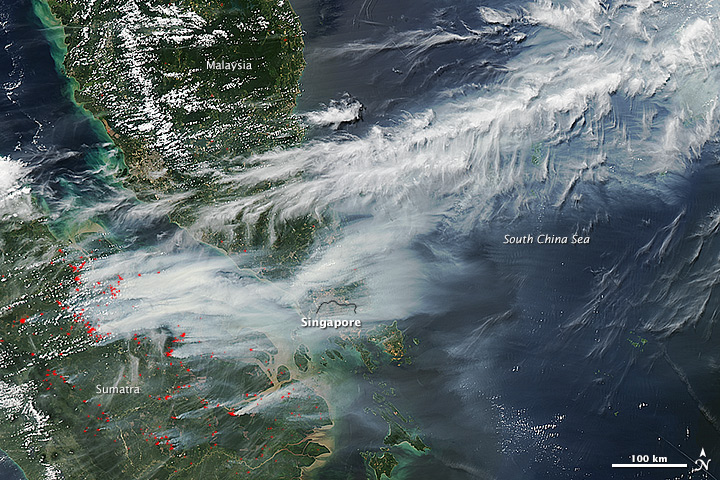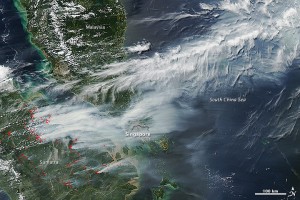
October 16, 2013, by Graham Kendall
What is Tropospheric Ozone Enhancement?
In this What is? series, we invite experienced researchers to write about their area of research, but in more general terms than they might normally do.
This article, entitled What is Tropospheric Ozone Enhancement?, is written by Muhammad Yaasiin Oozeer
If you would like to contribute, then please let me know (Graham.Kendall@nottingham.edu.my) and we can discuss how best to go about it.
Anybody wishing to contact the author of this article should go to about the author.
Ozone (O3) is a naturally occurring gas found in the atmosphere. It is mostly known to the general public as the ozone layer, which protects life on earth from harmful ultra-violet (UV) radiation from the sun. The ozone layer, for instance, has been made famous by media coverage on the ozone hole and the depletion of ozone in the atmosphere due to air pollution. That being said, ozone can be both beneficial and detrimental, depending on its location in the atmosphere.
The atmosphere is divided into several layers, the lowermost one being known as the troposphere. Its thickness ranges from 8km at the poles to 16km over the equator. Right above the troposphere is the stratosphere, which is separated from the latter by the tropopause. Ozone in the stratosphere can be considered as the beneficial ozone, given its protective characteristics. Tropospheric ozone however, is an air pollutant and a greenhouse gas which contributes to about 7% of the total global warming. In fact, tropospheric ozone damages infrastructure because of its reactive properties and also destroys living tissues. Ozone is harmful to both plants and human beings. It slows down the photosynthesis of plants and damages their internal cells. Most importantly, it affects people, especially those suffering from respiratory problems.
While ozone occurs naturally in the troposphere due to lightning during thunderstorms, Mother Nature keeps the ozone level in check through the reaction of ozone and nitric oxide to produce oxygen and nitrogen dioxide. Tropospheric ozone enhancement, or increase of ozone in the troposphere, hence occurs from externally induced causes. The main cause: air pollution from anthropogenic activity. In fact, ozone is not directly emitted in the troposphere; rather it is the result of the photochemical reaction of ozone precursors produced from combustion processes for power production and transport. Major ozone precursors are carbon monoxide (CO), oxides of nitrogen (NOx) and volatile organic compounds (VOCs).
Forest Fires and Tropospheric Ozone Enhancement in South East Asia
Forest fires, in other words biomass burning, also emit ozone precursor gases in the atmosphere in the form of biomass smoke. Forest fires can occur naturally due to lightning and hot and dry weather conditions. However nature is not the only culprit and growing industrial and agricultural needs have unfortunately led to man burning alarming areas of forest. The emanating smoke spreads in the form of haze, ozone being one of its constituents. Haze is a serious issue, especially when it affects cities and the people that live within. Malaysia and Singapore have recently suffered the effects of haze originating from peat and forest fires in Indonesia. This episode has seen both public health and economic repercussions which simply cannot be ignored. It is therefore primordial to be able to predict the occurrence of haze and its reach, and understand the climatic mechanisms involved so that a case can be made towards haze mitigation. Forest fires and tropospheric ozone are not a new phenomenon. In fact extensive forest fires reported in Indonesia occurred due to strong El Niño events in 1994 and 1997. An El Niño is a weather phenomenon which takes place over the Pacific Ocean. During an El Niño, the pressure around South East Asia and Australia increases and the climate becomes much drier than average; conducive conditions for forest fires.

Image captured by Moderate Resolution Imaging Spectroradiometer (MODIS) from NASA’s Aqua satellite on the afternoon of June 19, 2013. The red spots mark areas where the thermal sensors on the MODIS instrument have detected temperatures higher than background.
Source: http://earthobservatory.nasa.gov/IOTD/view.php?id=81431
Methodologies
Ozone enhancements in the troposphere can be determined through measurements taken by balloon-borne instruments called ozonesondes. Several methods can be used to determine the sources of tropospheric ozone. A first step involves carrying out back air trajectory analysis to determine the region from which the ozone has been carried by wind flow. Forest fires on the other hand can be located by extracting hot spots, or fire counts, from satellite images. If these hot spots correspond to the region determined by the back air trajectory analyses, this proves that the tropospheric ozone in fact originates from forest fires. Given the issues linked to tropospheric ozone, determining the source is not enough. As such the present study aims at using the Weather Research and Forecasting (WRF) model to study and predict the transport of tropospheric ozone from forest fires in South East Asia. The WRF model is a numerical weather prediction system which can be used in both atmospheric research and weather forecasting.
Muhammad Yaasiin Oozeer a PhD student whose work focuses on the transport of tropospheric ozone due to forest fires in South East Asia. He is currently working under the supervision of Professor Andy Chan at the University of Nottingham, Malaysia Campus.
Email: yaasiinoozeer@gmail.com, keex2myr@nottingham.edu.my
References
Carr, A., 2007. What is tropospheric ozone?. [Online]
Available at: https://web.duke.edu/nicholas/bio217/akcarr/
[Accessed 25 July 2013].
Fujiwara, M. et al., 1999. Tropospheric ozone enhancements during the Indonesian forest fire events in 1994 and in 1997 as revealed by ground-based observations. Geographical Research Letters, 26(16), pp. 2417-2420.
Skamarock, W. C. et al., 2005. A Description of the Advanced Research WRF Version 2, Boulder, Colorado: National Center for Atmospheric Research.
www.weather-climate.org.uk, n.d. Atmospheric Layers. [Online]
Available at: http://www.weather-climate.org.uk/02.php
[Accessed 25 July 2013].
No comments yet, fill out a comment to be the first


Leave a Reply